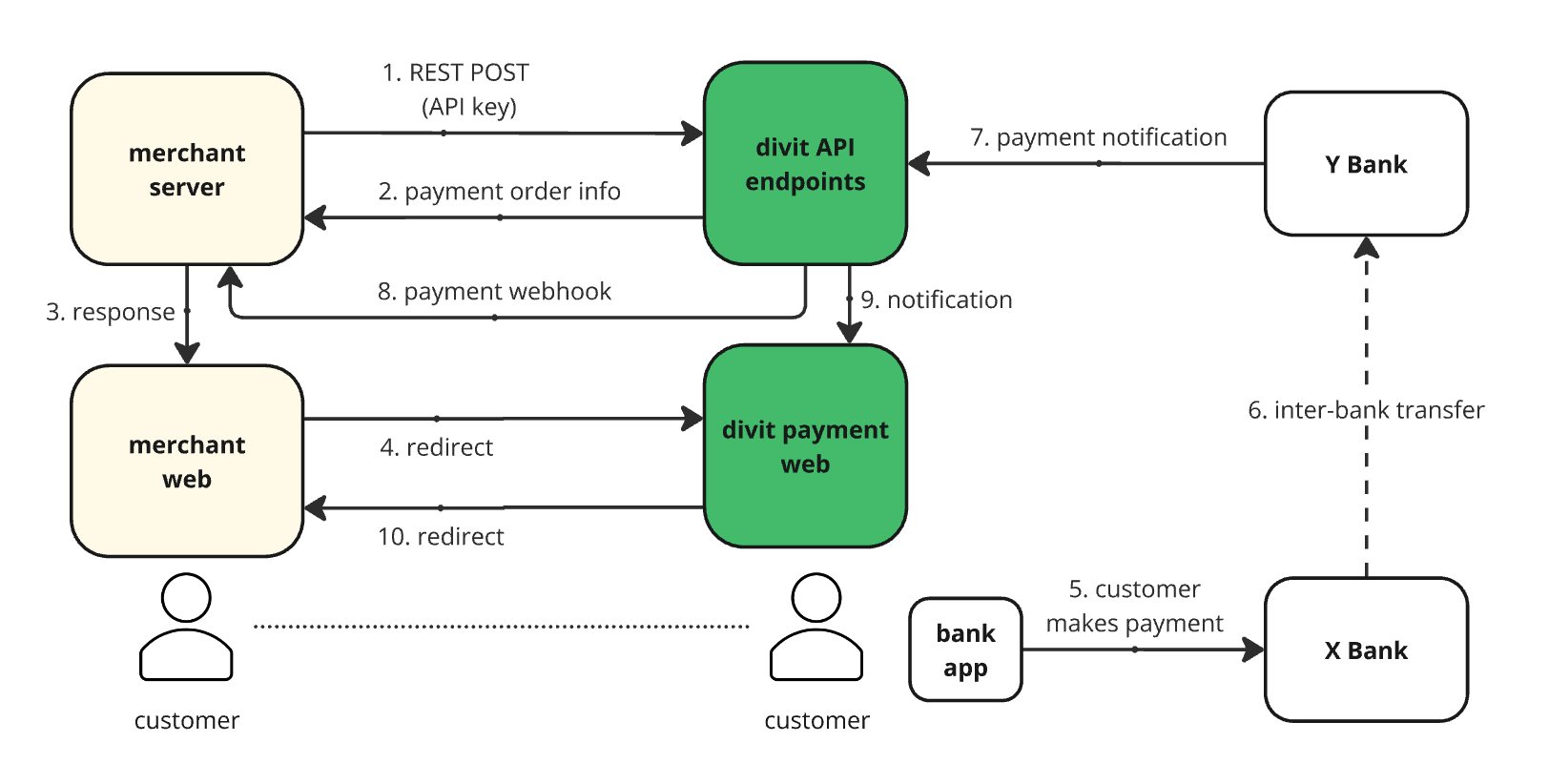create payment order
method 1
make a server-to-server call to create a payment order.
endpoint: POST {{API_BASE_URL}}/directpay/o/order
here is the workflow diagram showing the whole payment process.

steps:
- merchant server POST a create order request to divit server endpoint (step 1)
- divit response with JSON object contains redirect URI (step 2)
- merchant website redirect customer to divit payment screen (step 3 - 4)
- customer makes a payment, bank transfer money to divit account (step 5 - 6)
- bank send real-time credit notification to divit server (step 7)
- divit sends webhook call to merchant server, and push notification to divit payment screen (step 8 - 9)
- divit payment screen redirect user back to merchant website (step 10)
order creation API
to create a payment order, you'll need to supply both the order and customer information. ensure you include the API key in the request header for authentication. if you wish for your customers to get a e-receipt, or to join the divit reward campaign or lucky draw, you must also provide some customer contact information.
caution
all monetary values are in integer format. So, $987.50 = 98750
var data = JSON.stringify({
"order": {
"totalAmount": {
"amount": 0,
"currency": "string"
},
"webhookSuccess": "string", // URL for redirecting customer to after successful payment
"webhookFailure": "string", // URL for redirecting customer to after failure/cancelled payment
"webhookEvents": "string", // URL receives webhook events
"expiredAt": 1696654130, // unix time
"merchantRef": "string" // your reference ID that customer will see on the payment screen, max 36 characters
"merchantUniqueOrderID": "string", // in case you have another reference id, max 64 characters, it will be shown on transaction report
"language": "en" // we supports "en", "zh-hk", "zh-cn"
},
"customer": {
"firstName": "string",
"lastName": "string",
"email": "[email protected]",
"tel": "string",
"country": "HK", // ISO 3166-1 alpha-2 country code
"language": "en"
}
});
var xhr = new XMLHttpRequest();
xhr.withCredentials = true;
xhr.addEventListener("readystatechange", function() {
if(this.readyState === 4) {
console.log(this.responseText);
}
});
xhr.open("POST", "{{API_BASE_URL}}/directpay/o/order");
xhr.setRequestHeader("api-key", "{{API_KEY}}"); // e.g. dvt_rREeGJ4FXp69nQEJ7Arq08stvtacFyPrTzKr
xhr.setRequestHeader("Content-Type", "application/json");
xhr.send(data);
create order response
after creating the order, you will receive the redirectURI together with a token. the token is used to claim back the order created by the backend, linking the purchase session together.
redirect the user to divit with the URI value and append token as the parameter.
{
"code": 0,
"message": "OK",
"data": {
"redirectURI": "https://sandbox-pay.divit.dev/request/fps/<requestID>?signature=<signature>",
"orderID": "956db0a3-68b1-420c-9df9-3ec5d77136b9", // divit order ID {{DIVIT_ORDER_ID}}
"token": ""
}
}
redirect user
almost done! just redirect your user to the supplied URL, we will take it from there. now you can sit back and wait for our webhookEvents call.
function pageRedirect() {
window.location.replace("https://sandbox-pay.divit.dev/request/fps/<requestID>?signature=<signature>");
}
payment screen
the redirect link will bring your customer to our payment screen
web-to-app payment
divit supports web-to-app (app-to-app) payment. we can open the banking app and have all the payment information ready by one click on the payment screen.